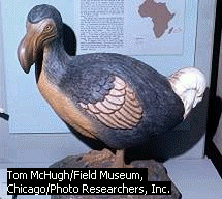
Endangered Species
Definition: Plant and animal species that are in danger of
extinction, the dying off of all individuals of a species.
Over 19,000 plant species and 5000 animal species around the globe
are classified as endangered, and many thousands more become extinct
each year before biologists can identify them. No more than one-tenth
of the estimated 10-50 million species of invertebrates (animals with
no backbones such as insects and mollusks) have even been described.
The primary causes of species extinction or endangerment are habitat
destruction, commercial exploitation (such as plant collecting,
hunting, and trade in animal parts), damage caused by non-native
plants and animals introduced into an area, and pollution. Of these
causes, direct habitat destruction threatens the most species.
Changes in the rate of
extinctions has increased exponenitally since the 1600.
A steady rate of extinction is a normal process in the course of evolution, and is called the background rate of extinction. Species have slowly evolved and disappeared throughout geologic time because of climatic changes and the inability to adapt to survive competition and predation. Since the 1600s, however, the rate of extinction has accelerated rapidly because of human population growth and resource consumption. Today the world's habitats are changing faster than most species can adapt to such changes through evolution, or natural selection. The current global extinction rate is estimated at about 20,000 species per year, exponentially greater than the background extinction rate. Many biologists believe that we are in the middle of the greatest mass extinction episode since the disappearance of the dinosaurs 65 million years ago.
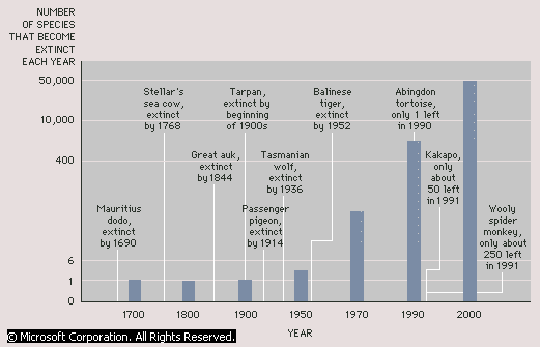
The survival of ecosystems (plant and animal communities and their
physical surroundings) such as forests, coral reefs, or wetlands
depends on their biodiversity, or variety of plants, animals,
and habitats, as well as the many interactions among these species.
The removal or disappearance of one or several species may
irreversibly damage the ecosystem and lead to its decline. For
example, the undersea kelp forest ecosystems of the northern Pacific
Rim are some of the richest marine habitats known-they are the home
or breeding ground of many species of fish and other wildlife, such
as sea otters. When the sea otter population off the western coast of
Canada and the United States was hunted almost to extinction in the
19th and early 20th centuries, invertebrates such as the sea urchin
were left without a major predator. The population of sea urchins
increased dramatically and rapidly consumed the kelp and other
seaweeds, turning the rich ecosystem into a barren undersea terrain.
Conservation efforts throughout the latter half of the 20th century,
such as the U.S. Marine Mammal Protection Act (1972), allowed for the
protection and reintroduction of the sea otter to these ecosystems
and the kelp forests once again thrived.
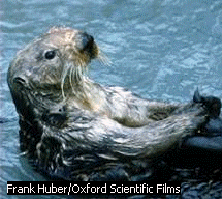
Loss of Biodiversity
The irreversible loss of biodiversity has a serious impact on the ability of remaining species, including humans, to survive. Humans depend on species diversity and healthy ecosystems to provide food, clean air and water, and fertile soil for agriculture. In addition, we benefit greatly from the many medicines and other products that biodiversity provides. As many as 40 percent of our modern pharmaceutical medicines are derived from plants or animals. A small plant from Madagascar, the rosy periwinkle, produces substances that are effective in fighting two deadly cancers, Hodgkin's disease and leukemia. Yet the forest habitat of the rosy periwinkle is rapidly disappearing to supply firewood and farmland for the impoverished people of Madagascar, and most of the endemic species there-that is, species that live nowhere else-are endangered.
Humans are trying to help
In the United States the Endangered Species Act of 1973, legislation enacted to protect endangered species and the habitats on which they depend, established two degrees of endangerment. Endangered species, such as the California condor, are at immediate risk of extinction and probably cannot survive without direct human intervention. Threatened species, such as the gray wolf, are abundant in parts of their range but are declining in total numbers and are at risk of extinction in the foreseeable future. In addition to these official categories, biologists recognize rare species, such as the greater prairie chicken, which exist throughout their range but in relatively low numbers. The World Conservation Union (IUCN), a nongovernmental organization compiling global information on endangered species, has established similar categories of endangered species, referring to the categories as critically endangered, endangered, and vulnerable.
What is Causing these global extinctions?
Distruction of Habitat
Species become extinct or endangered for a number of reasons, but the primary cause is the destruction of habitat by human activities. As species evolve, most adapt to a specific habitat or environment that best meets their survival needs. Without this habitat the species may not survive. Pollution, drainage of wetlands, conversion of shrub lands to grazing lands, cutting and clearing of forests, urbanization, coral-reef destruction, and road and dam construction have destroyed or seriously damaged and fragmented available habitats. Habitat fragmentation, the isolation and division of habitats into smaller areas, has caused plant and animal species in the remaining islands of habitat to lose contact with other populations of their own kind. This reduces their genetic diversity and makes them less adaptable to environmental or climatic change. These small populations are highly vulnerable to extinction. For some species, the fragmented habitats are each too small to support populations high enough to survive.
Commercial exploitation
Since the 1600s, worldwide commercial exploitation of animals for food and other products has caused many species to become extinct or endangered. The whaling industry, in which whales are slaughtered for oil and meat, for example, has led many whale species to the brink of extinction. The African black rhinoceros, killed for its horn, which is prized as a medicine and aphrodisiac, is also critically endangered. The great auk and the passenger pigeon became extinct in the 19th and early 20th centuries because of overhunting, and the Carolina parakeet perished as a species because of a combination of overhunting and habitat destruction. Virtually entire families of plants such as cactus, orchids and cycads are considered threatened or endangered because of over-collection for commercial purposes.
The introduction of competing species
Non-native species introduced to a new ecosystem have caused serious
native species declines. The non-native, or exotic, species may be
introduced either accidentally or intentionally, and either
out-compete the native species or prey on them. Native plants and
animals may have no defenses against these invaders, which can
exterminate or greatly reduce the populations of many native species.
The damaging effects are generally irreversible, and there is
often no way to keep the damage from spreading. The accidental
introduction of a blight, for example, virtually eliminated the
American chestnut tree from North American hardwood forests. The
zebra mussel, first discovered in North America in Lake Saint Clair,
Ontario, Canada, in 1988, is rapidly spreading to most of the major
freshwater ecosystems of the eastern United States, altering aquatic
ecosystems and displacing native mollusks at an alarming rate. In
1959 British colonists introduced the Nile perch into Lake Victoria
in eastern Africa as a sport fish. This large predator drastically
reduced native fish populations and caused the extinction of as many
as 200 endemic species of cichlid fish. Because the cichlids are
important algae-feeding fish, the lake has since become choked with
decomposing aquatic vegetation, depleting the oxygen in the water and
leading to further species declines.
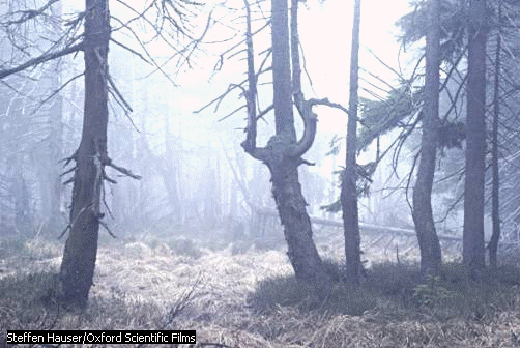
Pollution
Pollution is another important cause of extinction. Toxic chemicals-especially chlorinated hydrocarbons, such as dichlorodiphenyltrichloroethane (DDT) and polychlorinated biphenyls (PCBs)-have become concentrated in food webs, the interconnected food chains that circulate energy through an ecosystem. These toxic chemicals strongly affect species near the top of the food chain. (This means Humans) Both DDT and PCBs interfere with the calcium metabolism of birds, causing soft-shelled eggs and malformed young. PCBs also impair reproduction in some carnivorous animals. Water pollution and increased water temperatures have wiped out endemic species of fish in many habitats. Oil spills destroy birds, fish, and mammals, and may contaminate the ocean floor for many years after the event. Acid rain, the toxic result of extreme air pollution, has been known to kill organisms in freshwater lakes and destroy large tracts of forested land.
What can we do to help?
The Red List
In an effort to protect global biodiversity and encourage the study, restoration, and sound management of endangered species the IUCN and the World Conservation Monitoring Centre (WCMC) maintain a global list of endangered and vulnerable animal species called the Red List. A framework for international conservation efforts, the Red List database assesses the status of, and threats to, animal species worldwide. To add to this and other biodiversity databases, nongovernmental organizations such as Conservation International and World Wildlife Fund conduct periodic rapid assessments (focused, intensive evaluations) of biodiversity in various hotspots-regions like Madagascar that are both rich in endemic species and environmentally threatened.
We are getting the rest of the world involved
This information is used in the administration of international agreements such as the Convention on International Trade in Endangered Species of Wild Fauna and Flora (CITES), signed by 125 nations in 1973 and put into effect in 1975. The purpose of CITES is to restrict exploitation of endangered plants and wildlife by regulating and restricting their trade. Despite legal protection, however, the future of many species, such as the African black rhinoceros, is in doubt because of poor law enforcement and the activities of poachers and dealers who supply the $6 billion per year trade in endangered animals and animal parts. Similarly, the International Whaling Commission is charged with protecting global whale populations, but lacks the authority to enforce its rulings.
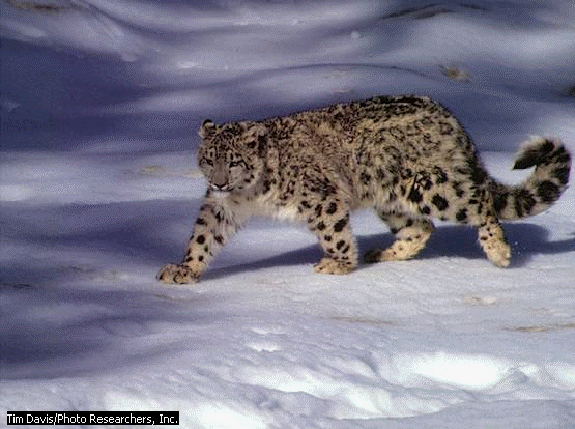 The
snow leopard, Panthera uncia, is found only in coniferous forest
scrub and mountain steppe regions of the Himalayas and surrounding
areas. Generally solitary in habit except during mating season, the
snow leopard may be found at 6000 m (19,000 ft) and higher in search
of migratory game such as wild sheep, ibex, and musk deer. It is
considered an endangered species.
The
snow leopard, Panthera uncia, is found only in coniferous forest
scrub and mountain steppe regions of the Himalayas and surrounding
areas. Generally solitary in habit except during mating season, the
snow leopard may be found at 6000 m (19,000 ft) and higher in search
of migratory game such as wild sheep, ibex, and musk deer. It is
considered an endangered species. 
Legal remedies
Several private and governmental efforts in the United States have been mobilized to save endangered species. One immediate approach is to protect a species by legislation. The Lacey Act of 1900 was enacted to protect wildlife from commercial trade and overhunting. The Marine Mammal Protection Act of 1972 banned the killing and importing of whales and nearly all marine mammals. In addition to promoting species and habitat protection in the United States, the Endangered Species Act (ESA) discouraged the exploitation of endangered species in other countries by banning the importation and trade of any products, such as elephant-tusk ivory, obtained from such species. Although the ESA is one of the most progressive national wildlife protection laws ever enacted, it is constantly threatened by development industries unhappy with the government restrictions.
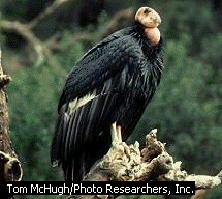
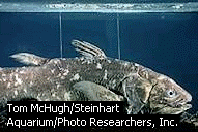
Countries work together
The United States also has various agreements with other nations like Canada and Mexico for the legal protection of migratory birds. These include the Migratory Bird Treaty Act of 1918, the Migratory Bird Conservation Act of 1929, and the North American Waterfowl Management Plan of 1986. Canadian laws designed to protect endangered species include the Migratory Birds Convention Act of 1917, the Canadian Endangered Species Protection Act of 1996, and the Wild Animal and Plant Protection and Regulation of International and Interprovincial Trade Act of 1996.
Captive breeding
Efforts to save endangered species also include captive breeding of severely endangered species later released in the wild to restore or add to a breeding population (a population of individuals capable of reproducing). Due to breeding in captivity (such as in zoos and specialized animal clinics), the number of known California condors has grown from 27 in 1987 to 121 by 1996, including 17 living in the wild in southern California; the number of whooping cranes has risen from 21 worldwide in 1941 to at least 158 in 1996; and the American peregrine falcon has been re-introduced into the wild in eastern North America where it had become extinct as a breeding population. These species, however, are still considered endangered.
Captive breeding is considered a last resort because such breeding may reduce the genetic diversity of the species and its ability to survive in the wild. For example, Pacific salmon raised in hatcheries may be less capable of surviving in adverse conditions than wild salmon, and if they interbreed with the wild fish, they may dilute the natural survival ability of wild salmon. Extremely difficult to successfully reintroduce to the wild, captive-bred animals are also more likely to carry disease, which they may transmit to the wild population. Captive breeding programs are extremely costly, sometimes reaching $500,000 per year per species. Moreover, captive breeding is a short-term repair that may divert attention from finding solutions to the original causes of the species decline such as habitat destruction or toxic pollution. For some species, however, such as the California condor and the black-footed ferret, captive breeding has made the difference between survival and extinction.
Conservation Biology
The scientific field of conservation biology evolved to study the complex problems surrounding habitat destruction and species protection. The objectives of conservation biologists are to understand how humans affect biodiversity and to provide potential solutions that benefit both humans and non-human species.
One of the approaches that conservation biologists study and implement is the development of habitat reserves and wildlife corridors. All species require a minimum amount of habitat for survival. Wildlife habitat reserves are established to meet these requirements for as many species as possible. Some national parks, wilderness areas, and other protected habitats are suitable for the survival of a wide range of species. Unfortunately, the minimum area required by large carnivores such as grizzly bears or cougars may be larger than the area protected in a reserve. In order to effectively enlarge the area available to the species, protected wildlife corridors that interlace or connect separate reserves may be developed. These areas are narrower than the actual reserve but ideally allow for unimpeded travel between reserves. Conservation biologists recommend that both reserves and corridors be surrounded by a wide belt, or buffer zone, of similar landscape to maintain the effectiveness of the reserve. Conservation biologists also study and promote habitat restoration and extensive public education, and work with ecologists and taxonomists (scientists who study the scientific classification of organisms) to identify and describe the millions of imperiled species not yet known to science.
Our greatest challenge
The current global extinction crisis is one of the greatest challenges posed by the rapid growth and expansion of human populations. The protection of endangered species and habitats should be a top priority for international organizations, governmental agencies, industry, and individuals if there is hope for preserving the earth's valuable biodiversity for future generations.